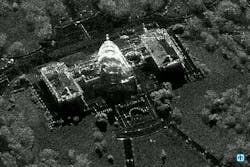This advanced radar must provide high frame-rate, three-dimensional imaging of objects through adverse obscurants like fog, smoke, and heavy rain, and efficient beam steering and radar imaging.
Officials of the Defense Advanced Research Projects Agency (DARPA) in Arlington, Va., released a solicitation this week (DARPA-BAA-14-53) for the Advanced Scanning Technology for Imaging Radars (ASTIR) program that seeks to design a cost-effective imaging radar system with similar performance to synthetic aperture radar (SAR).
DARPA experts will brief industry on the ASTIR program's technical details and goals from 8:30 a.m. to 4:30 p.m. on 18 Aug. 2014 at the DARPA Conference Center, Room 01-200, 675 N. Randolph St., in Arlington Va.
Related: DARPA to brief industry on through-clouds radar with imaging capability to match infrared
ASTIR technology will use one transmit and receive chain and electronic sub-reflector designs that produce a readily available, cost-effective sensor that does not require platform or target motion as in SAR or ISAR, DARPA officials say.
The ASTIR concept will minimize system complexity by using a compound antenna with an electronic sub-reflector that works together with a large primary aperture that would define the angular resolution of the radar.
Ways to do this could include replacing an electromechanically displaced mirror, as currently used in some imaging radars, with a planar electronically reflecting surface for beam steering; using phase-shifters on the sub-reflector to steer a small spot across the main reflector; or digitally modulating each element on the sub-reflector with an orthogonal phase code.
The ASTIR program's goal is to provide high-resolution 3D imaging for enhanced identification and targeting, independent of platform or target motion; well-focused images at speeds faster than 10 frames per second, even when there is no platform or target motion; and beam steering with one transmit and receive chain to reduce system complexity.
Related: Princeton Lightwave to develop military laser radar target imaging in DARPA LRT contract
This solicitation focuses on an electronic sub-reflector for use with a larger aperture to generate 3D images of stationary and moving objects. A government team, meanwhile, will identify potential military applications of this technology.
In 2016 DARPA officials say they will issue another industry solicitation to build prototype imaging radar systems that use the electronic sub-reflector for a specific military application.
This effort to develop a new kind of imaging radar electronic sub-reflector has two technical areas: electronic sub-reflector approaches, which will last for six months; and electronic sub-reflector prototype demonstration, which will last for 18 months. Several contractors are expected to be involved.
Companies interested should submit abstracts no later than 26 Aug. 2014 to the DARPA BAA Website at https://baa.darpa.mil. Abstracts submitted will help DARPA researchers weed out proposals that are not of interest. Full proposals are due no later than 10 Oct. 2014.
Email questions or concerns to [email protected]. Register for the ASTIR proposers' day conference no later than 15 Aug. 2014 online at www.solers.com/BAAinfo-reg/astir.
More information is online at https://www.fbo.gov/spg/ODA/DARPA/CMO/DARPA-BAA-14-53/listing.html.



